TurtleStitch gives way to a collaborative community as represented by this paper. The paper itself is based on a 24-week Sunday morning Zoom workshop with participants from all over the world. Tea & TurtleStitchers: Karen Blumberg, Kristin Burrus, Lina Cannone, Lan Heng, Marina Jackson, Margaret Low, Beth Lloyd, Sarah Magner, Simon Mung, Heather Allen Pang, Julia Quinto, Maria Beatrice (Bice) Rapaccini, Tracy Rudzitis, Andrea Mayr-Stadler, Paul Wege, and Elaine Wolfe.
In 1971 Seymour Papert and Cynthia Solomon published a paper, “Twenty Things to Do With a Computer,” based on our experience teaching with Logo. (The original paper is republished in this issue of the CITE Journal.) Logo was the first computer language developed specifically for children. This paper is a continuation of that work, 50 years later.
The Origins of Turtles
Logo and the idea of a computer environment and culture for children came about at a time when dramatic change in education seemed possible. The United States had lost the race with the Soviet Union to be the first to launch a satellite. This competition led to a large amount of funding to improve K-12 education, especially in mathematics and science. Change was proposed in what was taught as well as how things were taught. In some ways it was a heady time full of outspoken and courageous protests about the way things had been.
As the first year-long Logo class drew to a close in 1969, Seymour saw success and yet felt a need for something more. It was not enough for learners to play with words and numbers and sentences. A more concrete object was needed. The turtle was born – a creature on wheels that could be commanded to move and turn. By 1970 there were floor turtles and a display turtle (on a display monitor), both having pens with which to leave a trace of their paths.
Although Seymour encouraged people to think about other microworlds, the turtle world with turtle geometry remained the fullest, richest, and most copied microworld. For example, after 50 years of playing with turtles, Cynthia is deeply absorbed with a turtle that makes designs for computerized embroidery machines.
The Origins of TurtleStitch
Transitioning a turtle to draw stitches on a screen might seem obvious once it has been done, but it needed the imagination of Andrea Mayr-Stalder to tie embroidery to programming a turtle. With Michael Aschauer as developer, TurtleStitch has been implemented in Snap!, which has been built on many of the principles of Logo.
A series of commands guide the turtle in much the same way in both Snap! and TurtleStitch. The turtle has drawn a triangle in the illustration below. The reset and running stitch blocks are TurtleStitch additions that control the way in which the design is programmed by clearing off the turtle’s stage and selecting the type of stitch to be used on the embroidery machine (Figure 2). The rest of the code is the same as in Snap!
Figure 1. TurtleStitch code and turtle obeying the code

For us, TurtleStitching is a personal and expressive medium for creating embroidered designs. It encourages geometric thinking in imagined and real space. At the same time, we are struck by the beauty of debugging code and design together while also confronting the realities and peculiarities of the embroidery machine itself.
The Computer as an Expressive Medium
TurtleStitch extends the idea of the computer as an expressive medium. The computer might be good as a number cruncher, a carrier of rote learning techniques, a deliverer of information, or a repository of well-formed or not-so well-formed ideas, but it also allows us to express ourselves by mixing math, science, art, and so on, into new forms. The original “Twenty Things to Do With a Computer” paper was full of such activities. Our intent, here, is to continue in that tradition.
These things reach into important realms of knowledge, such as mathematics, art, design, and composition. What TurtleStitch coding provides is an immediate sense of control and creativity. The example in Figure 2 illustrates the way in which a spiral triangle drawn on the computer screen has been translated into an embroidered design on a piece of fabric.
Figure 2. Turtle drawing on screen and design drawn on the computerized embroidery machine

Envisioning the computer as an expressive medium allows us to be both teacher and learner and to explore our worlds with no fear of going amok. Why? because what seems to be amok provides us with opportunities to examine and reflect on what happened and what fixes might rescue the situation. Fifty years ago this examination was called debugging and the amok details were bugs. The major activity of coders was debugging. Finding bugs in code could then be related to bugs in thinking about other things both physical and mental.
The activity of debugging and constructing artifacts like programs still offers the teacher or learner a sense of empowerment. You create something in your own style and get it to work. You can give it a unique design, different from anyone else’s or just like someone else’s. The choice is yours.
The Challenge for Teacher Education
The computer’s presence has offered a new opportunity to improve the quality of education. At the same time, it has created a new educational challenge that emerges when we ask how people learn to use computers and what computing environments are available to them.
For educators, a nagging question is, “How do I learn to use computers today in a way that will not be obsolete in 5 years?” The answer requires a vision of the future. It helps to examine prior innovations and their underlying theoretical issues. These issues span the traditional concerns of philosophers, psychologists, educators, and computer scientists. In fact, the ideal computer educator emerges as one with a foundation in each of these disciplines.
Nonetheless, educational innovations carry with them a continuing concern — the problem of transmitting theory into practice. The process of transmission often contributes to the trivialization of educational innovation.
For anyone daunted by emerging maker technologies, the computerized embroidery machine seems docile. It looks like a sewing machine and grandma can use one of those. TurtleStitching might be the answer for getting into the power and grace of making. The results are quickly experienced (unlike 3D printing, for example).
The Design Process
For us, the making process of creating an embroidered design can be divided into four parts:
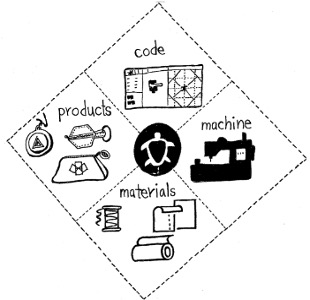
- generating code in TurtleStitch,
- putting the design into the computerized embroidery machine,
- amassing assorted materials (fabric, thread, needles, seam rippers, snippers, stabilizers, hoops, etc.) and finally,
- printing the embroidery and using it to create a product.
As teachers, researchers, and learners in the Tea and TurtleStitch workshop, we searched for compelling things to do. Here, we share an introduction to coding in TurtleStitch for a computerized embroidery machine that inspired the more than 20 things we have investigated that totally turned at least one of us on.
Introduction to Tea & TurtleStitch and the Tea & TurtleStitchers
Tea & TurtleStitch was supposed to be a 6-week workshop held online through Zoom and open to anyone. Susan, an active Tweeter, posted a notice on Twitter and an invitation on the FabLearn google group. More than two dozen people responded. Most of them were scattered around the United States, but there were also people from Austria, China, Germany, Great Britain, Italy and Sweden. We assumed they were educators with an interest in making and doing with young people. Most had little or no experience with TurtleStitch and turtle geometry and some had no experience with coding.
Our collaboration (Cynthia and Susan) in preparing for Tea & TurtleStitch was an aha experience for each of us. Much of what we did was motivated by suggestions from the other Tea & TurtleStitchers. We learned new ways to think about turtle geometry and new things to do. We moved away from recursive code to for loops and forevers combined with conditionals. We also engaged with wiser turtle geometry friends on fundamental issues about turtles, polygons, and spirals. (Our advisory cohort mostly consisted of Margaret Minsky, Artemis Papert, Brian Silverman and Oliver Steele.}
Each workshop meeting contained a mixture of surprise, delight and focus. Our approach revolved around sharing some “sandbox” code. After introducing each sandbox activity, we paused for individual “Tinkering Time” in the sandbox. Afterwards, TurtleStitchers shared what they created and discussed their code. For some sessions we had guests who brought new insights and activities to our meetings. Our guests included outstanding TurtleStitchers: Richard Millwood [a], Jadga Heugle [b], Simon Mong [c], Margaret Low [d], Margaret Minsky, [e] and Andrea Mayr-Stadler [f].
Our activities involved creation of embroidered geometric designs – polygons, spirals, overlapping circles, hearts, and non-figurative art. There were a variety of end products including quilts, gnomes, puppets, embroidered bags, sweatshirts, and a cloth book. Some Tea & TurtleStitchers even explored ways in which movement through running or skating could be translated into embroidered designs.
The rest of the paper contains at least 20 things to do created by us and the Tea & TurtleStitchers:
Geometric Designs
1. Make Designs with Polygons, Stars, and Spirals
2. Stitch Some Science!
3. Revisit the Craft of Teaching and Design a Heart
4. Create a Design Inspired by Fibonacci
5. Design a Turtle Track
6. Recreate Islamic Art
7. Create a Lotus Flower
Objects
8. Create a Whimsical Embroidery Stitch Guide
9. Make a Quilt
10. Make a Gnome
11. Make a Finger Puppet
12. Be Inspired by Ed Emberley and Create a Design that Glows in the Dark
13. Combine Bio-tinkering with Embroidery
14. Create an Embroidered Bag
15. Design a Sweatshirt for a Club
16. Make a Cloth Book
17. Design a Coffee Cozy
Kinesthetic Maps
18. Recreate a Skating Pattern
19. Create a Map of a Daily Run
20. Create a Star Map
21. Communicate a Message
22. Think of Another Thing!
More than Twenty Tea & TurtleStitch Projects
Geometric Designs
1. Make Designs with Polygons, Stars and Spirals – Cynthia Solomon, Educational technologist, researcher, & teacher, Somerville, MA
I love making embroidery designs with the turtle. I tell it to move a certain amount and turn a certain amount and then Wow! I am often surprised by the result. The hardest part of coding a design with the turtle is deciding on when the job or part of the job is done – that is, making a Stop Rule.
How do I give commands to the turtle to make a polygon? First, I want to tell you a little bit about where the turtle lives. Then I want to tell you a little bit about polygons. I focus on two kinds of equiangular polygons: regular polygons and star polygons.
The TurtleStitch environment has three main sections: a palette, where the blocks are kept; a scripting area where the blocks are assembled into useful stacks and new blocks are made; and a stage where the turtle is located (Figure 3).
Figure 3. The coding environment

The turtle lives on the stage. The stage is a grid of points that are described by x (horizontal) and y (vertical) coordinates. The center point is where x is 0 and y is 0.
Turtle behavior has come to be known as turtle geometry. Turtle geometry has an interesting theorem called the Total Turtle Trip Theorem. This theorem states that the turtle eventually returns to its starting state if it moves a constant amount and turns a constant amount. (An exception occurs when the turtle turns 0 or 360 degrees, whereupon it will walk in a straight line and never get back to its starting state.) This theorem holds true for all kinds of polygons.
In contrast to Euclidean geometry, the amount that the turtle turns to draw a polygon is based on the external angle of the turn rather than the internal angle. For example, in turtle geometry the turtle turns 120 degrees on each turn to make a triangle (i.e., the external angle of the turn) while in Euclidean geometry students learn that the internal angle of an equilateral triangle is 60 degrees.
In Figure 4 the turtle makes a 24- sided polygon; it has so many sides it looks like a circle. We can now make a special block of code for this. Next we can change the move command’s input and see the almost-circle get bigger or smaller. Try 53, 33, 42, and so on.
Figure 4. A first project

For making a polygon turning 15 degrees, you need 24 sides or 360/15.
To make a hexagon (a six-sided polygon) with a side of length 100, we divide 360 by 6 to get the turning angle between each side (Figure 5).
Figure 5. Turtle draws a hexagon

In the same way, to make a pentagon, 360 is divided by 5 to get the number of degrees in the turning angle (Figure 6).
Figure 6 Turtle draws a pentagon

One of the cool things in TurtleStitch is that you can make your own blocks. Figure 7 is a block called regularpoly that tells the turtle how to make a regular polygon using two inputs, the length of the side and the number of turns (or number of sides in the polygon) and an example of using it to make an octagon.
Figure 7. A regular polygon block and seeing the turtle draw an octagon

If you change the second input to regularpoly to 3 the turtle will draw a triangle.
How do we make a star polygon? This is a bit tricky without knowing the angles. Here is a method for discovering the inputs that is easy to play with. We edit regularpoly and add another input, called multiplier. We need to find a multiple of 360 that is divisible by the number of turns. But there can be more than one multiple with a beautiful result (Figure 8).
Figure 8. A polygon block that tells the turtle to make any equangular polygon including star polygons

My favorite turns to play with are 11- and 13-sided polygons. Increase the multiplier 1-11 and explore on your own.
A spiral polygon block is like a regularpoly block except the length of each side is increased after each turn. The number of repeats is the number of turns of the spiral (Figure 9).
Figure 9. Code that makes the turtle draw spirals with turns like regular polygons

Something to try is turning the turtle a little more or less than, say, 360/4 (Figure 10).
Figure 10. Code for skewing a spiral

Figure 11 is a block for spiraling with an extra input called, extra turn. It allows you to change the turn from, say, 90 degrees (360/4) to 90 + 2 degrees as pictured above.
Figure 11. Code for a general spirals block

Almost any input results in an interesting artistic variation. Playing with polygons results in startling and beautiful designs. Making new designs in this way becomes magical and compelling and truly inventive.
2. Stitch Some Science! – Kristin Burrus, Innovation Program Manager & Lead Teacher, Global Center for Digital Innovation, Chattanooga, TN
One sunny day in June 2021 I spent all morning collecting beautiful and interesting shells along the coastline in Sanibel, FL. It was then that I realized I wanted to make embroidery to remind me of the shells I found and the feelings I experienced walking along the beach. As a science teacher, I have always loved the intersection between math, science, and art. At the time, I had no idea how to even begin coding a Fibonacci spiral. Fortunately, when I zoomed into Tea & TurtleStitch from the beach on that sunny day, I learned how to make arcs and spirals. Figure 12 is an example of the code and the shells which inspired the design. (See also Figure 13.)
Figure 12. At the beach collecting shells and learning to make arcs and spirals

Figure 13. Code inspired by shells and its on-screen results and its stitched result

For students who don’t have the luxury of being inspired by the beauty of nature in person, pictures are often a reasonable substitute. After finding this amazing picture of an animal cell online (3D Rendering of a Eukaryotic Cell https://gaelmcgill.artstation.com/projects/Pm0JL1). I made my own version in TurtleStitch (https://www.turtlestitch.org/run#cloud:Username=forestmom&ProjectName=Cell%20Organelles), trying to focus on general similarities in the shape of various organelles, particularly the mitochondria, tubulin, lysosome, and transport vesicle. I feel the variegated thread truly helped capture the vivid colors of the rendered image (Figure 14).
Figure 14. Vesicles and embroidered example

I also made a video of TurtleStitch rendering my design: https://drive.google.com/file/d/1TgRZXuYwSdhmGAkkIGbZp7iXfmr1-npD/view?usp=sharing
These experiences have energized me to create a Problem-Based Learning (PBL) unit for a life science classroom. I taught middle and high school science for 18 years before focusing on STEM in a K-12 Fab Lab. As a result, I am passionate about connecting content standards to PBL units that focus on making. I believe that PBLs are a brilliant way to teach content standards that are embedded in the making process. When we design something about which we are passionate or find beautiful or fascinating, the desire to learn to code and how to use computer-controlled embroidery machines becomes intrinsically motivating. Then technical skills become secondary to content skills (science, math) and essential skills (creativity, collaboration, communication, and critical thinking).
3. Revisit the Craft of Teaching and Design a Heart – Marina Jackson, Technology Teacher, The Brearley School, New York, NY
When I joined the Tea & TurtleStitch group I had no idea what a great impact it would have on my teaching. Going into it, I thought I would gain a better understanding of how to use TurtleStitch and maybe I could gather some tips on how to use an embroidery machine; it ended up being a regenerative journey that encouraged me to reflect deeply on my ideas of education, the learning process, and the importance of learning through discovery.
I started my career in 1985 teaching kindergarten. At the time, I firmly believed in the value of a constructivist approach; kids learn by doing, they draw insight from experience, they construct their own meaning from their interactions with materials and their peers. Children should be able to make choices about what to learn and how to learn it. I had formed this opinion not only from observing the children I taught, but also from my own experience as a student.
For the past two decades I have been working at a traditional school teaching technology at the elementary, middle school, and high school grades. For years I had required that my students build every program, block by block, from scratch; I did not provide them with prebuilt blocks and prohibited remixing code.
After collaborating with the Tea & TurtleStitch group, I have come to realize that this preconception is a fallacy; there is much value in exploring other people’s programs, for it gives you another perspective and greater insight into other ways of solving a problem. This helps you grow both creatively and intellectually.
The most important “rediscovery” I experienced with the Tea & TurtleStitch Group was how crucial it is to have hands-on learning. Telling and showing only go so far, especially with children. I’ve learned to continue showing and telling so students have an overview, but keep it brief.
While seeing the output of code gives instant feedback on the screen, the experience of working with materials yields greater understanding on a physical level. In addition, the joy in realizing abstract code into a physical object, in creating something from nothing, is invigorating, incredibly rewarding and satisfying on so many levels.
I found that many of my 10- to 12-year-old students are interested in drawing hearts, stars, and flowers, so I created starter code for each of these endeavors and then sat with small groups of students, breaking down each task and modeling problem solving. For instance, to draw a heart I show them how a heart is really just two semicircles and a “vee”; we then step through solving first the abutting semicircles and then figure out the angle and distance for the “vee.” Figure 15 is the code one class created in a group code session (https://www.turtlestitch.org/users/turtlestitchtea/projects/heart):
Figure 15. Code for a heart and the turtle’s drawing

The journey never ends! My journey with TurtleStitch is just beginning. Having spent about six months playing with code and machine embroidery, I am finally bringing my interest into teaching a new unit in my fifth grade Technology class. Every class, I am brought back to rethinking why I am teaching something, constantly reflecting on what long lasting benefit students can gain from this experience, and how I can inspire students to take ownership of their learning. I know there will be many more “takeaways” in this journey, and I am looking forward to continuing my quest for meaning, with both my students and Turtlestitch as my teachers.
4. Create a Design Inspired by Fibonacci – Paul Wege, STEAM Teacher & Maker Educator, SocialTech e.V. Frankfurt, Germany
After one of the Tea & TurtleStitch Sunday sessions, a tweet from Vicent Pantaloni @panlepan, whom I have been following for some time and who always presents amazing mathematical shenanigans with GeoGebra, caught my attention. Content of the tweet: “Squirals = spirals from squares” (Figure 16; @panlepan, 2021, June 12. Vincent Pantaloni. Twitter. https://twitter.com/panlepan/status/1403833411505213443)
Figure 16. A squiral cover from Geogebra

What could be more obvious than to deal with something like that in TurtleStitch? Actually, squares and spirals are quite nice on the embroidery machine, but not really a challenge. What if you combine arcs and squares? Squarcs? Where to find something like this?
I remembered that 25 years ago I visited the first hands-on mathematical museum in the world and was confronted for the first time with the occurrence of the Fibonacci sequence in nature. In Gießen, a small town near Frankfurt/Germany, is a permanent mathematics exhibition in the Mathematikum (https://www.mathematikum.de/) where visitors can touch mathematics and experiment for themselves on about 200 objects. .Directly in front of the museum some cones were laying under a pine tree. Just like the seeds of sunflowers, the so-called bracts of these cones are arranged in spirals around the center. The number of right and left spirals always corresponds to a Fibonacci number. This insight made a lasting impression on me.
But there is more to the Fibonacci numbers: If you recursively divide a golden rectangle into a square & a golden rectangle and draw a quarter circle with the radius equal to the edge length of the square, you get the so-called Golden Spiral where the radius of the circle sectors corresponds to the numbers of the Fibonacci sequence.
The basics were there: Squares are simple and we had just implemented the function for circular arcs. How do you put it all together?
This is where the simple idea behind TurtleStitch comes in: You can execute each command “one by one” because each block can be clicked separately and then the activity of the block is executed.
This means that you can approach the algorithm for solving a task in single steps. Especially for first time programming with children, this is an enormous advantage because they can directly test the correctness of their code each time.
The Fibonacci sequence starts with (0), 1,1, 2, 3, 5, … So we start with a square with edge length 1. It works for the first two squares and then there is a problem. The starting point of the next square is always diagonally opposite the end point of the current square. The quarter circle through the current square is necessary for the spiral; it starts at the end point of the square and ends at the start point of the next square (Figure 17).
Figure 17. Drawing the spiral

Figure 18 shows the code with the setup for variables like the number of passes, the number that is the current element of the series, the previous number in the series, the length of the current square’s edge (https://www.turtlestitch.org/users/turtlestitchtea/projects/fibonacci_2%20cynthia).
Figure 18 Changing the value for pass to 1, 2, 3, 4, 6 results in the examples above

Changing the value for pass to 1, 2, 3, 4, 6 results in the examples above (Figure 19).
Figure 19. The fibonacci spiral as a wall hanging

A crucial difference to the conventional approach of coding becomes clear at this point: while progress in program development is measured in “functionality”, it’s different with TurtleStitch. It is about manufacturing a product, i.e. about holding something in your hand at the end, I would call it “production oriented”. And thus the approach is fundamentally different. What is no problem as a function in GeoGebra or Processing can become a challenge for a manufacturing machine.
And that can be the main advantage for the students. With TurtleStitch, they are forced to understand the process of construction. In the example above, it has to be clear how to construct each geometric shape mathematically correct because without this knowledge, manufacturing with a machine cannot be implemented.
5. Design a Turtle Track – Paul Wege, STEAM Teacher & Maker Educator, SocialTech e.V. Frankfurt, Germany
My wife and I are proud owners of an Appaloosa horse. There are standard patterns in the various disciplines of Western riding competitions. These describe the figure that must be ridden. Referees then judge the results of riding competitions based on these patterns.
To recreate the riding patterns in TurtleStitch like Figure 20, you must analyze the structure of the patterns and then create your own corresponding pattern blocks in TurtleStitch. These can be combined to form any sequence (https://www.turtlestitch.org/users/turtlestitchtea/projects/ranch%20riding%20%3B-). There is a direct reference to the real world. To implement this, it is necessary to analyze the individual parts and break them down into suitable pieces of code. The machine is also subject to the limitations of the real world. This must be considered when coding in TurtleStitch.
Figure 20. The turtle track
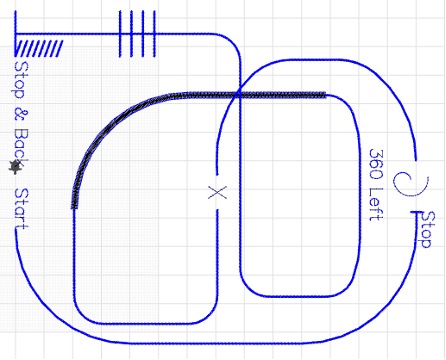
6. Recreate Islamic Art – Tracy Rudzitis, Creative Technologist – The Idea Lab, The Marymount School NYC, NYC New York
In their art history class, students at the Marymount School of New York were studying the art of the Islamic period. Turtlestitch seemed to be the perfect environment to explore the mathematical construction of these beautiful patterns and closely examine the structures of the patterns by immersing themselves in a playful approach to generating shapes.
The star polygon is a recurring shape in Islamic Art and one of the most recognized geometric designs in much of the non-figurative Islamic decoration. (http://gallery.bridgesmathart.org/exhibitions/2015-bridges-conference/blbodner and Bodner, B. Lynn. “Bourgoin’s 14-Pointed Star Polygon Designs.” Bridges Pécs: Mathematics, Music, Art, Architecture, Culture : Conference Proceedings, edited by George W. Hart and Reza Sarhangi. Proceedings of Bridges 2010: Mathematics, Music, Art, Architecture, Culture, 2010, archive.bridgesmathart.org/2010/bridges2010-135.html.) Stars can be drawn by rotating polygons, these motifs can then be tessellated or repeated to form the larger pattern. This seemed to be a perfect entry point into an exploration of using shapes as the foundation of building patterns with symmetry and repetition.
As part of their class, these students visited the Islamic galleries at the Metropolitan Museum of Art. I asked them to record some of the shapes and patterns they felt drawn to. These designs could be used as inspiration for their work in Turtlestitch, but it was made clear that their own work was not expected to be an exact replication or duplicate of existing patterns, but a point of inspiration and a context to think from and to imagine what the process was for the artists of the time and their inspirations. The role of mathematics and geometry is believed to be central to Islamic Art. Proportional geometry was used as a visual expression and abstract representation of harmonious shapes and proportions which reflect beauty, unity, and order as evidenced in the universe created by God (Figure 21).
Figure 21. A polygonal design

In class I chose to focus on the construction of motifs that could be generated using polygons. It would be an opportunity to introduce the idea of abstraction, a central concept in computer programming.
The unexpected surprises that appear can then be developed into designs with increasing complexity. The addition of rotation blocks, the use of circles, using mathematical expressions to calculate turning angles and spacing, are all strategies that can be used to generate shapes that are connected, interlaced, duplicated, rotated, to produce a single motif that will be the student’s contribution to the finished class project (Figure 22).
Figure 22. Tiles from the museum and embroidered tiles by students

I was inspired by a display of hexagonal tiles at the Met as a way to display the completed work (Metropolitan Museum of Art, editor. “Tile Panel mid-16th century.” The Metropolitan Museum of Art, www.metmuseum.org/art/collection/search/447625.). There are approximately 70 students in Class IX so I envisioned each of their motif designs enclosed in a hexagon and tiled as a display on the walls in the school.
7. Create a Lotus Flower – Bice (Maria Beatrice) Rapaccini Mathematics Teacher, I.S.S. Cuppari, Jesi (AN), ITaly
Symbols and sacred geometry have always fascinated me. In particular, the Lotus flower is one of the most ancient and deep symbols I have seen. In a creative computing course I took before joining Tea & TurtleStitch I was asked to create a Mandala using the language Processing (Figure 23).
Figure 23. Mandala in Processing and an image of a Lotus Flower
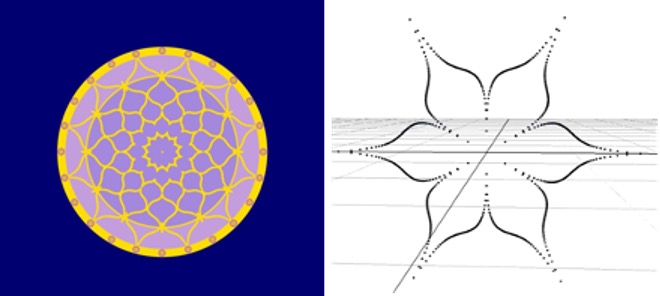
While I was programming the Mandala I thought about introducing the Lotus form. I found help in understanding the equations from the web site of Bethany Krupiarz (https://sdm.scad.edu/faculty/mkesson/vsfx705/wip/best/spring14/bethany_krupiarz/proj1/Mel_Matrix.html), a visual designer. I converted the equations into Processing with a satisfying result.
When I joined the Tea & TurtleStitch workshop group, I started thinking about creating a physical object with my new embroidery machine. The experience of creating a digital product or a combination of digital/physical product is quite different (Figure 24 and 25). Certainly, the digital one has the ability to have fewer restrictions and limits in creating beautiful pictures and products compared to a physical one. To create a Mandala on the screen I would not have thought of the number of points drawn, because the image was considered understandable even if some point missed. Whereas using the embroidery machine I was forced to write a code to avoid stitches thickened otherwise the machine could break. In fact, I did a lot of debugging activities to repair the machine, like regulating the needle and the bobbin thread, choosing the right strength for the thread, choosing the right needle (I broke one). (https://www.turtlestitch.org/users/turtlestitchtea/projects/Lotus%20Flower%20by%20Bice)
Figure 24. TurtleStitch code for Lotus Flower and the turtle drawing
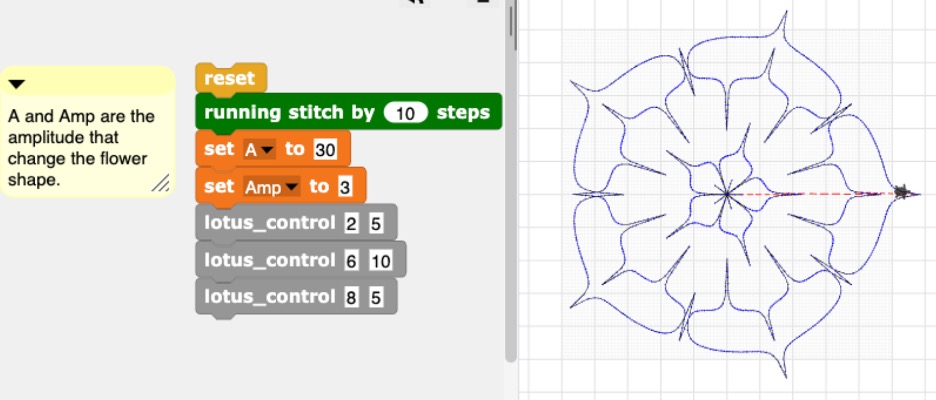
Figure 25. Embroidered Lotus Flower
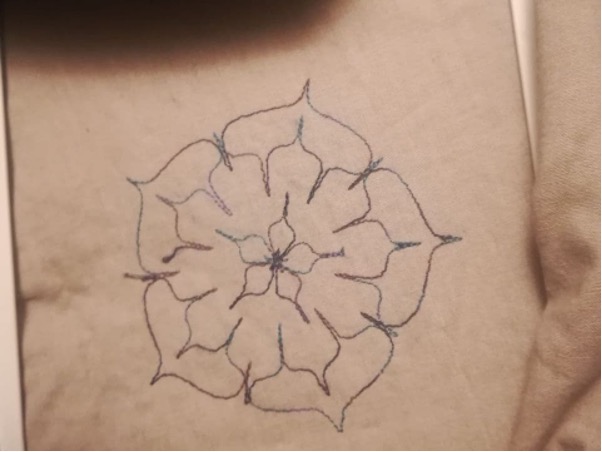
Link to get pictures
Objects
8. Create a Whimsical Embroidery Stitch Guide – Cynthia Solomon & Susan Klimczak
Some TurtleStitchers have not done hand (or “analog”) embroidery and may be unfamiliar with the names and styles of embroidery stitches! Others who have done hand embroidery might be curious how the stitches actually look when embroidered from TurtleStitch. This is where having a physical embroidery stitch guide is a powerful tool.
Figure 26 is an example that shows how the different stitches look with the same design (a pentagon; https://www.turtlestitch.org/users/turtlestitchtea/projects/pentagonstitches).
Figure 26. Different embroidery stitches for the same design, a pentagon
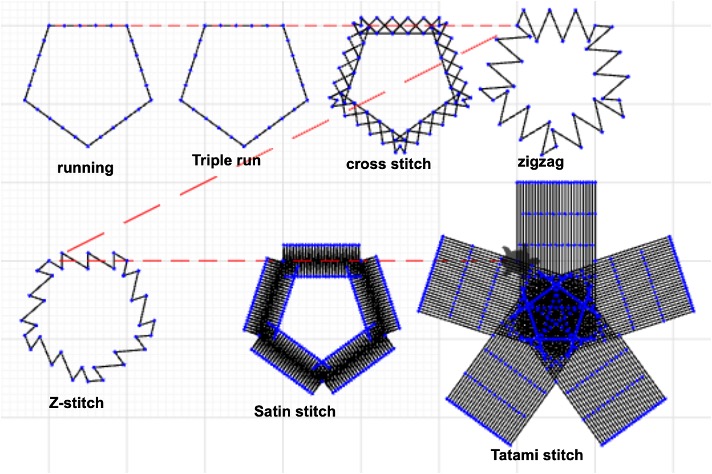
We designed the embroidery stitch guide in TurtleStitch (Figure 27; https://www.turtlestitch.org/users/turtlestitchtea/projects/stitches):
Figure 27. The embroidery stitches

Figure 28 shows two whimsical examples we made for Tea & TurtleStitchers to hang in their classrooms. where The stitch guide is embroidered on one side and a design using different stitches is on the other side. Each is embellished with hand-sewn beads and a handle for hanging on the wall. To make them even more whimsical, we went down to the local fabric outlet and bought some beaded trim from their remnants section to add some bling!
Figure 28. Whimsical wall hangings
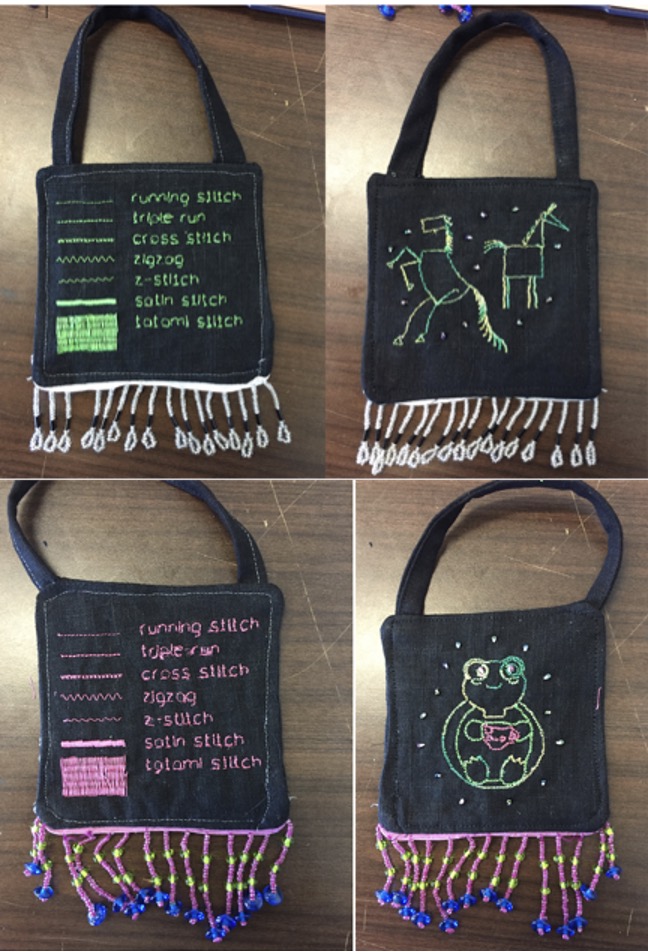
9. Make a Quilt – Elaine Wolfe, Innovator and blogger (https://papercraftetc.blogspot.com/)
This embroidered block quilt is my sampler (Figure 29), a collection that represents the culmination of six months of learning to code in TurtleStitch (https://www.turtlestitch.org/users/Elaine/projects/g/shared).
Figure 29. A quilt made from 25 different TurtleStitch designs
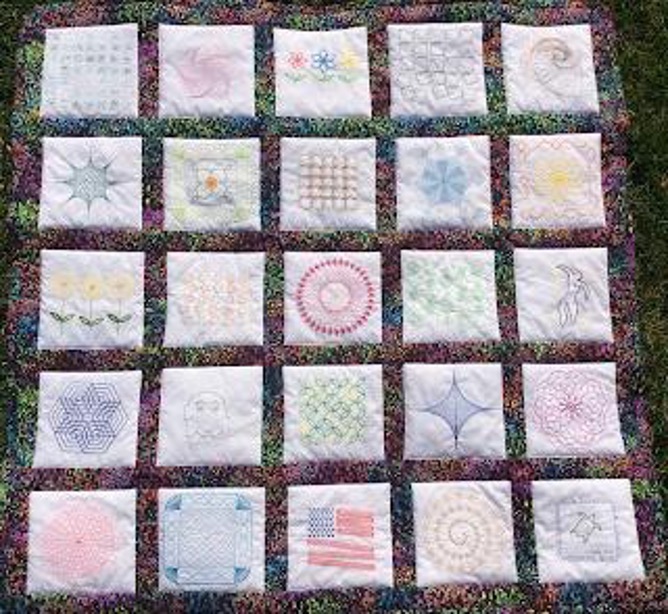
On this journey, I rediscovered my love of coding. (I haven’t coded in over thirty five years when I was a systems programmer working on IBM System/360 mainframe computers.) TurtleStitch is based on Snap!, a powerful “drag and drop blocks” programming language; with TurtleStitch you create designs for an embroidery machine or an electronic paper cutter like the Silhouette or Cricut machine. Turtlestitch designs can be exported as SVG files for the paper cutter or dst files for the embroidery machine. (The Silhouette machine’s software requires the Designer Edition or above is to open SVG’s.)
I loved coding the designs and reimagining them by changing variables, adding different proportions and random numbers. Sometimes, changing one variable, an entirely different design was created. I also enjoyed changing the size and type of stitch being used. This change could emphasize different parts of the design. I liked imagining what the design would look like with different colors and types of embroidery thread (variegated thread) before embroidering it. While the design was being embroidered, it was delightful to see its fabrication. It was mesmerizing to see the needle at work, moving around the hoop creating stitches that finally created the coded design.
Each of the twenty-five Turtlestitch designs that I coded during this workshop are intriguing and unique. I fabricated each of the embroidery blocks and combined them to make this block quilt.
My Brother PE 800 embroidery machine embroidered over a half million stitches while on my six month TurtleStitch coding journey.
10. Make a Gnome – Julia Quinto, Teacher & GATE Coordinator, Rustic Lane Elementary School, Jurupa Valley, CA
How do you capture the spark of a 5th and 6th grade class in a public school setting? Why, with TurtleStitch, of course. But it is not just seeing the embroidery machine in action that excites the students and sets the room a buzz; it is the knowledge that it is their own coded designs that are being stitched that ignites that fuel to want to learn.
Crafting naturally leads to the creation of things that are useful and practical, and thus gives purpose and meaning to the very thing that I am making. TurtleStitch does just this; it ties technology and crafting together. Students use computational tinkering to create physical items that they can hold, feel, and use. It gives students a reason to code, rather than just to code itself. TurtleStitch projects can be simple enough for a one-day project or complex enough for an ongoing project.
The Hour of Code week came in early December when classroom activities were not as fast paced and chaotic. It was the perfect time to introduce TurtleStitch to students. This led to a gnomes project for a holiday door decorating contest (Figure 30).
Figure 30. Two gnomes
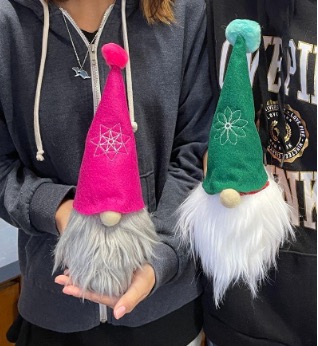
Some amazing math conversations came up that otherwise would not have surfaced during the time students were coding: “How many degrees make up a polygon; what about a circle? How many turns can the turtle make before it comes back around without overlapping?” Even the most interesting lesson in a geometry unit would not have generated these inquiries from students. Soon, students were sharing their designs, telling me about the geometrical features of their shapes. This is the essence of what project-based learning should look like.
The gnomes turned out so cute; each one of them was as unique as my students! Students voted to title our door “Chillin’ with my Gnomies” to mark the season. A flat door just wouldn’t do justice to the hard work the students placed on this project so a tree was the perfect touch for the gnomes to hang out near. We added branches, a tree swing, and a snow blanket along with student made snowflakes and toadstools to brighten up our door. By the way, the “Chillin’ with my Gnomies” door display won first prize in our school door decoration contest (Figure 31).
Figure 31. The finished gnome door
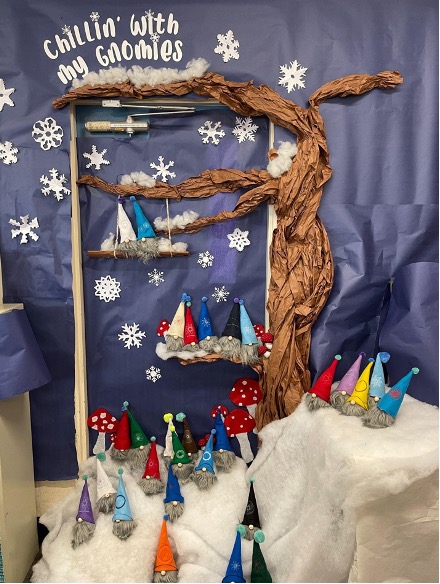
11. Make a Finger Puppet – Margaret Low, Director of Outreach and Widening Participation, WMG, University of Warwick, Coventry, UK
TurtleStitch bridges the world of programming and textiles enabling the creation of stitched patterns on materials in a way that is accessible to young and old alike. It brings a very creative and practical dimension to computer programming. Practical activities encourage students to explore, understand and interrogate technology for themselves (Figure 32).
Figure 32. Completed finger puppets
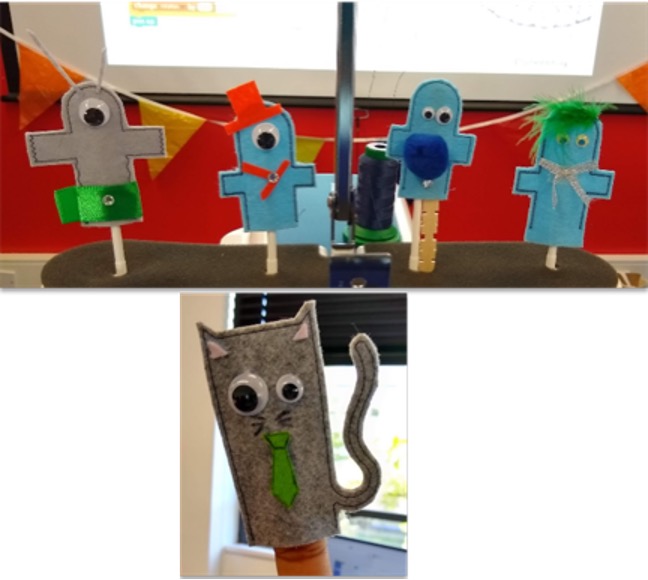
We have developed a range of resources, so we can use TurtleStitch in our outreach activities at the University of Warwick (www.warwick.ac.uk/turtlestitch), including construction of finger puppets. Each activity is accompanied by an activity card (Figure 33).
Figure 33. Instructions for the puppets

TurtleStitch helps people to understand how modern products are designed and manufactured. Much of our current manufacturing is done by programmable machinery. Products can be designed virtually that are difficult or impossible to manufacture. This can be seen with TurtleStitch when too many stitches are used on the wrong fabric.
Physical computing is often used in the ‘programming and control’ sections of the school curriculum in the United Kingdom. The aim is to give young people a deeper understanding of how modern devices work. These devices are embedded in our society and everyday life. It shows how devices are controlled using software, and how software and hardware interact.
The link to textiles opens many possibilities for interdisciplinary activities and builds links to culture. Many cultures have distinctive textile crafts; and how textiles are decorated often celebrates the culture of their creator.
12. Be Inspired by Ed Emberley and Create a Design that Glows in the Dark – Susan Klimczak
One of the most stimulating Tea & TurtleStitch challenges was to create a design inspired by the art instruction books by Ed Emberley (https://www.wbur.org/news/2015/02/13/ed-emberley). Tea & TurtleStitchers made so many creative designs.
I decided to use one of Ed Emberly’s skeleton designs (https://bit.ly/3HBVOzY) as an inspiration and put the Skellie on a Skateboard, because the Boston teen youth teachers and college mentors with whom I work love both skeletons and skateboards.
I fell in love with this design (https://www.turtlestitch.org/users/turtlestitchtea/projects/skellieonskateboard). It was so engaging to build up and debug its parts step by step. I used ideas from other Tea & TurtleStitchers, too. For instance, the embroidery machine has a tough time with very small width satin stitch circles, but embroiders tiny star polygon designs easily, so I used that strategy for the eyes and skateboard wheels (Figure 34).
Figure 34. Skellie code and image
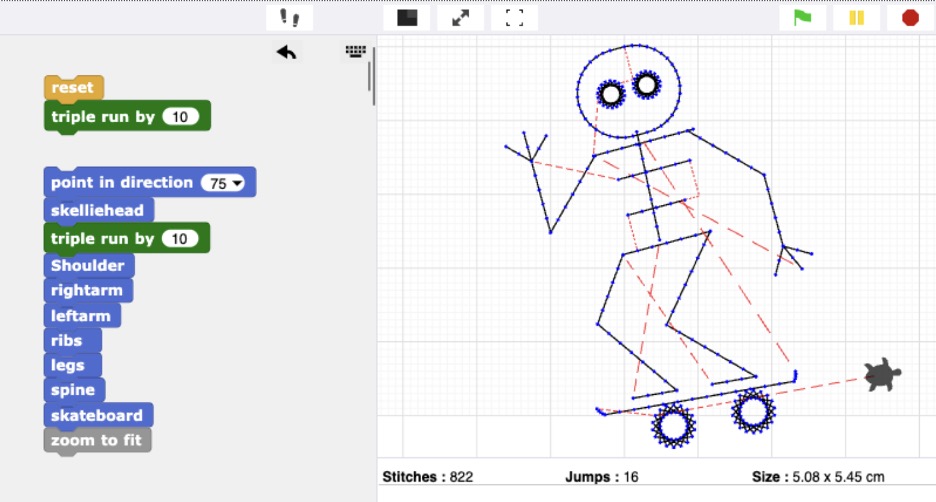
For the final design, I threaded the embroidery machine using a glow in the dark specialty embroidery thread to up the coolness factor. I made a pin by beading a circle around the skellie and sewing a pinback on the reverse side and I embroidered it on a thrift shop shirt I bought for one of my college mentors!
13. Combine Bio-tinkering with Embroidery – Lina Cannone, Primary Technology & Maker Teacher, Istituto Comprensivo Orazio, Pomezia (RM), Italy
I work with second grade boys and girls in a primary school in Italy located in a peripheral neighborhood where there is a lack of structured opportunities or places to socialize. Often there is no family support network. The population is increasing both due to internal immigration of families who move to this area for work and from immigration from outside the European Union.
We are currently exploring embroidery using kombucha leather. Kombucha is a fermented beverage enjoyed for its unique flavor and health benefits. The fermentation process can be used to create kombucha leather. This flexible material can be embroidered with designs created in TurtleStitch.
Children must wait, observe, and understand whether the conditions are right to form the material. This leads to a two-fold action: caring for something so that it can develop, and scientific observation of variables to assess the best conditions for growth and/or production of the material.
Due to the children’s age, we could not use difficult coding activities. Each student drew a computer component on paper (Figure 35).
Figure 35. Children’s drawings put on screen
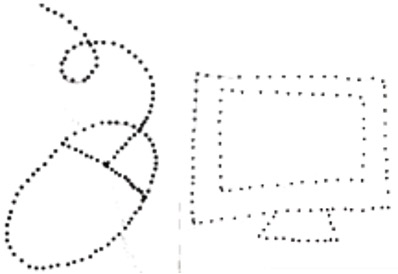
The next step was to use the embroidery machine; we used 2 water soluble stabilizers one on the top and the other on the bottom of the dried scoby to have more resistance (Figure 36).
Figure 36. Embroidered design

After stitching we put the scoby on water and we dried it again (Figure 37).
Figure 37. Final products

Biotinkering and TurtleStitch are still new activities in Italian schools. It has been great to experiment and learn with my students. In my classes, I found that students learn to minimize waste because of the time required to produce the materials. The students also learned other new skills such as managing analog and digital files and how to import and export data.
14. Create an Embroidered Bag – Heather Allen Pang, History Teacher, Castilleja School, Palo Alto, CA
I came to Tea & TurtleStitch because despite earlier efforts as a maker educator to “learn to code” I did not feel that I had progressed with any particular coding language to the point where I could see myself as proficient and reliable to make things with code. I am, however, an experienced quilter and bag makerI love fabric, I love sewing, and I love patterns. This was my way into coding. Stitching from code creates a tangible and wonderfully tactile test of the code itself, and a beautiful object to think with.
One of the most wonderful and important things about TurtleStitch is the beautiful and detailed projects one can create. Stitching from code creates a tangible and wonderfully tactile test of the code itself, and a beautiful object to think with (Papert, S. (1980). Mindstorms: Children, computers, and powerful ideas. New York: Basic Books. 11.). Once I started creating and designing patterns and drawings in TurtleStitch, I wanted to make things out of the designs, and make more designs out of which to make things. At the time, I was also enrolled in a bag making class taught by Vanessa Vargas Wilson, aka “the Crafty Gemini” (Video link to the Crafty Gemini’s youTube channel. https://www.youtube.com/c/TheCraftyGemini/videos), so I set out to combine my two classes and create project bags out of patchwork made with my TurtleStitch designs. I made several bags with different TurtleStitch designs (Figure 38).
Figure 38. Assorted bags with TurtleStitch designs
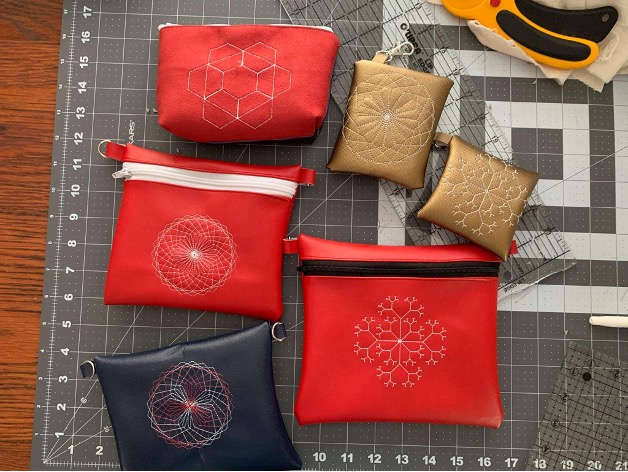
I took on a project to make the Vega Project Bag Pattern with eight different TurtleStitch designs. It took me several months to complete but it was buoyed by the Sunday morning discussions (Figure 39).
Figure 39. Using TurtleStitch designs to make a different kind of bag
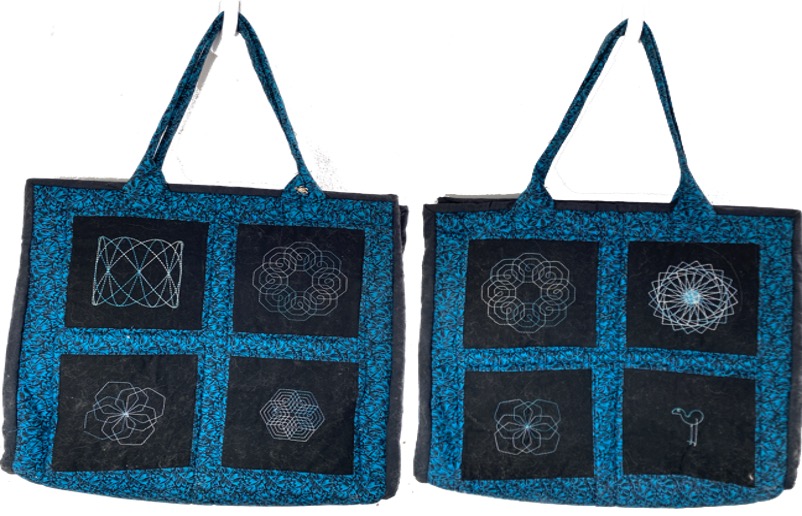
Sewing builds skills and confidence while creating beautiful and functional ways for students to show off their coded creations. For me, the fact that I could use my coding inspired me to do more coding and more stitching.
15. Design a Sweat Shirt for a Club – Karen Blumberg, Technology and Innovation Coordinator at The Brearley School, New York City
I am a Technology and Innovation Coordinator at a K-12 girls’ independent school in New York City. I am the faculty advisor for the Student Tech Club and the co-heads want to have a club sweatshirt. They cleverly realized blank sweatshirts cost a fraction of the price of custom printed sweatshirts. One of the students is designing a logo that we will embroider onto their sweatshirts. I can’t wait!
16. Make a Cloth Book – Elaine Wolfe, Innovator and blogger (https://papercraftetc.blogspot.com/)
I have made many projects using TurtleStitch with fabric – a quilt, miniature cloth books, stuffed doll sized Teddy bears, an appliquéd doll dress, earrings and a simple tote bag (Figure 40). A miniature cloth book can be created by folding over a design to create two pages.
Figure 40. Making a cloth book
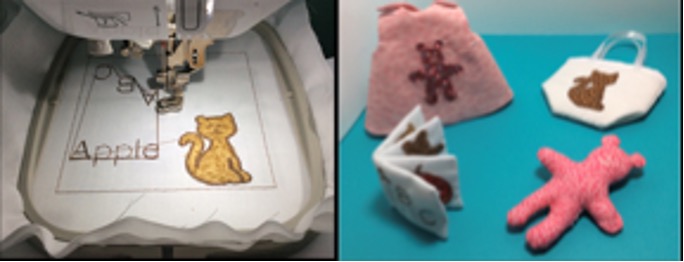
17. Design a Coffee Cozy – Sarah Magner, Innovation Lab Teacher, Flint Hill School, Oakton, VA
Each fall, my students and I take some time to thank some of the unsung heroes around our school. year we decided to code thank you cards in TurtleStitch. They decided to make a coffee cozy to go along with their coded cards so that our facilities, housekeeping, and security teams could have a present to feel extra appreciated (Figure 41). The students used calipers to measure a disposable coffee cup. For an extra special touch, they embroidered designs on the coffee cozies too.
Figure 41. A coffee cup and its cozy
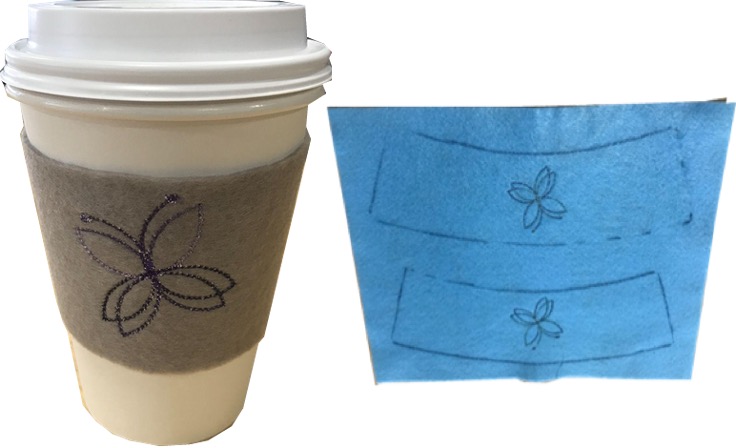
Kinesthetic Maps
18. Recreate a Skating Pattern – Simon Mong, Independent researcher on graphic computer languages and related mutidisciplinary learning, Suzhou, Jiangsu, China
I plunged into graphical programming when my daughter was about to enter primary school. As a product of the traditional Chinese education system, I treat block coding languages as tools to teach children how to code. After collaborating on many different projects with kids, I learned about TurtleStitch from the retweets of Jens Mönig, the lead developer of Snap!. The beautiful and complicated patterns coded in TurtleStitch attracted me strongly.
Even today in China students still learn nearly everything by reciting. I wanted a more engaging way to allow students to be more active and creative. TurtleStitch opened a door to teaching coding in a free and creative way for me.
After my daughter was hooked on skating, I noticed every child could learn to skate by themselves and I got really interested in comparing skating and coding in TurtleStitch. I concluded they have the following in common:
- The rink is like a stage in TurtleStitch, skaters move in the rink while the turtle moves on the stage.
- The skaters move step by step and so does the turtle. The simple moves generate fun and joy.
- Skaters can learn from others on the ice and TurtleStitchers could learn from shared projects.
- Learning to skate and learning to code in TurtleStitch are both good practices of constructionism.
I thought that if every child could learn skating by themselves, then every child might be able to learn coding through TurtleStitch (Figure 42).
Figure 42. Children skating and TurtleStitch design with curves and turns

I encouraged some children to learn skating step by step. They all managed to skate slowly in two sessions. Then I gave them several workshops on how to code in TurtleStitch. It’s an interesting experiment and I am happy to see they were more engaged in coding than other students.
19. Create a Map of a Daily Run – Beth Lloyd, Retired school-based occupational therapist; innovation specialist, Newport, RI
I worked as an occupational therapist in public schools. Seymour Papert observed that children perceived the turtle’s movements in relation to their own, moving their bodies as if they were the turtle. Once computers came into the classroom, I created sensorimotor experiences by letting students essentially be the turtle.
Running is an important part of my life. When I first began to learn TurtleStitch, I thought that creating a map of my daily runs might help with my coding experience. I became the turtle and my immediate environment became the stage. I planned a route that would be easy to code but also be an interesting design (Figure 43).
Figure 43. A route map on paper and a TurtleStitch design printed on fabric
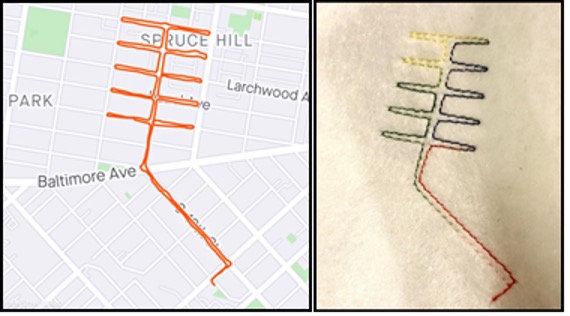
Although I have run these streets on endless occasions, I find myself more engaged, loving the experience and looking forward to seeing if what was in my mind matched the map. Sometimes it does not match up, but I always know the glitch, where I went wrong and what I need to do to fix it next time. I might not always run with a code in mind, but I usually sneak in a bit of code somewhere. I’m hooked (or cursed) because I know I will continue to run, one stitch at a time.
20. Create a Star Map – Lan Heng, Computer Teacher, Ethical Culture Fieldston School, New York City
Students in my fifth-grade class imagined looking at stars in the night sky and drew stars on paper. They then explored repeating a move and a turn to create star shapes in Turtlestitch (Figure 44).
Figure 44. A TurtleStitch star map
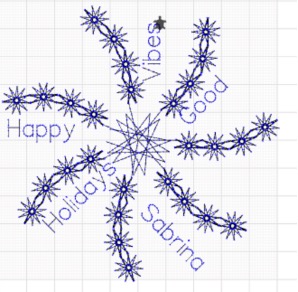
They learned how to use variables to change the size of stars. Students learned to use coordinates to place stars and star designs in specific positions. The next exploration was to create star designs either by rotating and or moving their star shapes to create new patterns. Everyone coded a different design using their favorite star shapes to create a night sky pattern filled with different sizes and shapes of stars.
21. Communicate a Message – Andrea Mayr-Stalder, TurtleStitch Founder, Artist, Educator, and Project Manager at Vienna University Children’s Office
As TurtleStitch founder and project leader, most of the time I am focused on running the TurtleStitch platform, on making decisions about the next development steps on the platform and on raising funds that even a largely volunteer-driven project requires. I find it extremely enriching to be part of the community myself and to be able to use that participation to understand the diverse needs of the users and to learn a bit about their social, educational, and general cultural contexts. Besides that, we sometimes just have fun by creating together.
One of the things that keeps me motivated is that TurtleStitch is a tool with a lot of different uses. Depending on the type and context of activities you can shift the focus on a wide range of things: Coding, Mathematics, Geometry, Creating for different physical outputs (Embroideries, Cuttings, Vector graphics, Etchings), f2f Teamwork, Distance Learning, etc. A lot of experienced computer scientists have contributed patterns to the TurtleStitch archive which is also an interesting resource to the field of Turtle Geometry and you often see well known Turtle Geometry patterns prepared for embroidery outputs.
In these activities, one could say, put the focus on the tool aspect of TurtleStitch and the different approaches for teaching computational thinking that it offers. In the following, however, I want to focus on the motivation of using TurtleStitch as a tool for a different kind of creative expression, beyond the joy of creating things and learning itself.
In my latest coding project I wanted to program an awareness ribbon because many projects and issues I care about are using ribbons as a way of creating awareness. What makes ribbons an interesting project is that while the form is relatively generic – many different issues are using the similar ribbon design – it is the color that generates the specific meaning.
Thus, a ribbon as a basic design is still quite open because it is the color of the thread chosen in the physical stage of making, that defines the meaning, rather than the computational design. As for the ribbon, I will stitch it out in pink (breast cancer awareness).
Bringing concrete, meaningful issues to which the learning of coding can be applied can be an important motivation for the learning context. For example, a citizen’s laboratory for social and digital innovation, in Cornellà de Llobregat, Barcelona (CitiLab)created a workshop called Taking Care of Bees. This workshop is designed for diverse groups of participants (for example family- and non-formal learning). It addresses Life on Land, the fifteenth goal of the seventeen Sustainable Development Goals (SDGs) which concerns halting biodiversity loss. The Lesson plan for this workshop and related Petal Shape Cards are available at http://turtlestitch.citilab.eu/
Figure 45. Assorted TurtleStitch designs
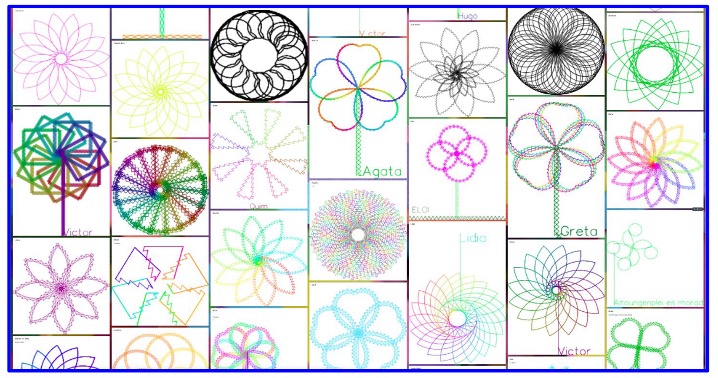
There are a number of projects that can be categorized as awareness raising. These are projects that have messages or statements that are important to their creators and that they want to express and spread. For example, Michael Aschauer’s Data Visualisation project converts the data of atmospheric CO2 from the last 800,000 years into an embroidery pattern.
TurtleStitch can be used to explore and find a voice for issues that matter in the particular context that people are living. Here, TurtleStitch can be a medium of social and cultural engagement and also of political speech, expressed through individual or collective crafting.
Figure 46. Finding atmospheric data and using to decorate your hoodie
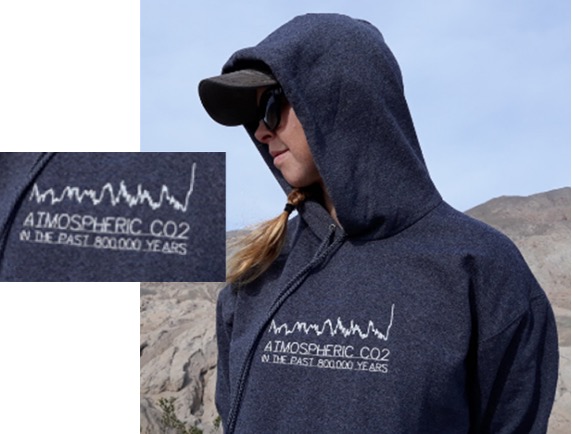
22. Think of Another Thing!
Notes
[a] https://www.turtlestitch.org/run#cloud:Username=Richard&ProjectName=Molnars%20cubes
[b] https://www.turtlestitch.org/users/jadga/projects/pixel%20draw%20program%20t-rex
[c] https://www.turtlestitch.org/run#cloud:Username=SimonMong&ProjectName=turtleSpiral
https://www.turtlestitch.org/run#cloud:Username=SimonMong&ProjectName=fancy%20skating2
[d] https://warwick.ac.uk/fac/sci/wmg/about/outreach/resources/turtlestitch/
[e] https://www.turtlestitch.org/users/margmarg/projects/Intricate%20inspired%20by%20Huw
[f] https://www.youtube.com/watch?v=B-EGVQR9Aa4
![]()